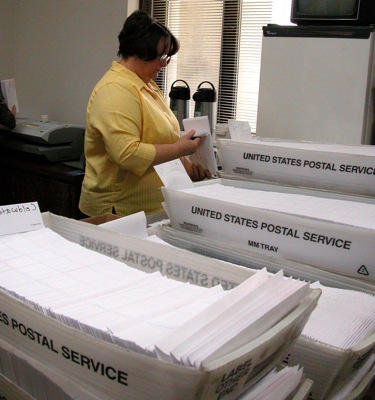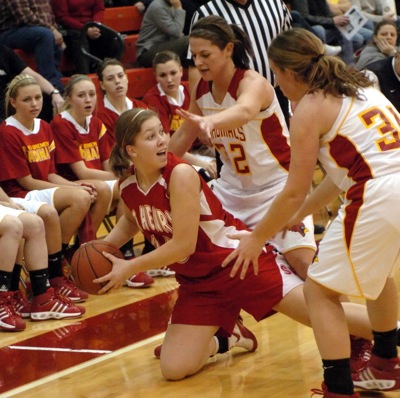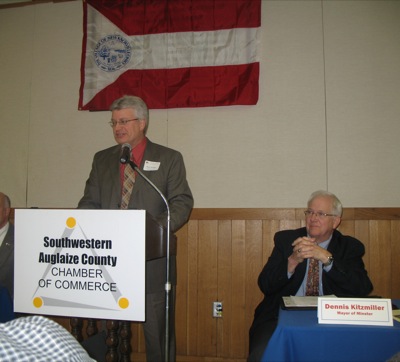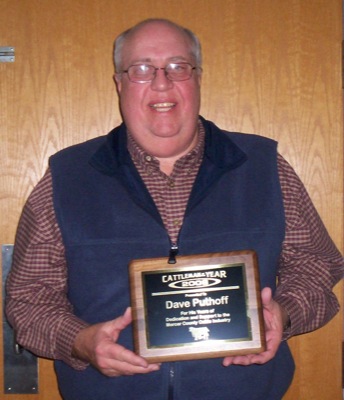Friday, January 23rd, 2009
Home values rise amidst gloom
Average increase is 3.98 percent in Mercer, 5 percent in Auglaize
By Shelley Grieshop

Photo by Shelley Grieshop/The Daily Standard
Mercer County Deputy Treasurer Sherry Black checks the postmark on real estate tax bills that are being mailed out today. Some residents - particularly farmers - may see higher tax bills this year due to an overall increase in property values across the Grand Lake area from state-mandated appraisals.
Area residents may be confused to learn that in today's bleak economy their home and property values have increased - a factor that may be reflected on real estate tax bills coming out this month.
After reviewing home sales and other factors in the Grand Lake area from 2005 through 2007, the state department of taxation recently issued results of its triennial update and recommended that county auditors raise property values an average of 4 percent in Mercer and 8 percent in Auglaize counties.
However, auditors in both counties performed their own in-depth calculations - but not physical appraisals of property - and adjusted the percentages with the approval of the state. The real property values ultimately increased an average of 3.98 percent in Mercer County and an average of 5 percent in Auglaize County.
The reason property values have increased overall is due to a positive housing market locally in 2005 through 2007. Home sales in 2008 and foreclosure are not in the figures.
Mercer County Auditor Mark Giesige said some Ohio counties issue across-the-board property value adjustments following triennial updates, but he doesn't believe that's fair to all communities. Poorer villages would likely get short-changed, he added.
"Some people will see a zero increase and others may go up as much as 7 percent," Giesige said referring to the 3.98 percent average.
Ohio law dictates that property values be adjusted every third year to bring the figures into the acceptable range of fair market value. Fair market value is defined as the value that land would transfer between a willing seller and a willing buyer.
The fair market price of most local properties - as assessed by the state and county - is much lower than the properties are actually selling for today, officials said. Property taxes are then figured against 35 percent of the fair market price set by the state.
Auglaize County Auditor Janet Schuler said she asked the state "pretty much on hands and knees" to lower their 8 percent recommendation and was granted the 5 percent average. However, since tax bills were sent out in early January she's gotten considerable backlash from the public.
"This (raising property values) is very hard to do in this environment. We're not San Francisco or Los Angeles or even Cuyahoga County where they've had huge decreases in home values. People here just don't understand," she said.
Schuler said her office has received phone calls from disgruntled residents asking, "Are you crazy?" and saying, "Don't you read the newspapers to know housing prices are going down."
Some of the highest increases in land values in Auglaize County occurred in New Bremen and Minster; the lowest were noted in St. Marys, Schuler said.
She and Giesige said they'd like residents to know their hands are tied; the triennial evaluations are state-mandated.
Giesige said his message to local residents is don't sweat the news: "This isn't a gloom and doom situation like we're hearing about in the bigger cities. This is good, our property values have risen. This is what homeowners want to see."
Farmland taxes increase:
The value of some local agricultural land has increased more than 300 percent and the news will surface this month as farmers receive their real estate tax bills.
The adjustment in farm land values is due to some major changes in the Current Agriculture Use Valuation (CAUV), which is set by the state every three years in every county. The most recent CAUV study was conducted by the state in 2008 for the years 2005, 2006 and 2007 and will be reflected on 2009 tax bills.
The purpose of the state's CAUV program is to bring the county's agricultural land appraisals in line with current usage value, not fair market value as homes are assessed for tax purposes.
CAUV assessments are based on a detailed formula that fills 22 pages. Soil types and their value in crop production are a major determination of land assessments. There are more than 50 types of soil in Mercer County and about 3,650 across the state, according to Mercer County Auditor Mark Giesige.
An example of the increase in value of soil types is Millgrove silty clay loam, the highest-valued soil type in the county. It previously was valued at $570 per acre but has increased to $1,100 per acre, Giesige said.
Area farmland has for years been "heavily discounted" and the new CAUV standards are an attempt to bring values up to speed, he said.
"It will still be a shock to farmers," he said, sympathizing with farmers who've also been hit in other ways by the failing economy.
The new land values are set by the state and cannot be appealed, Giesige added.
- Shelley Grieshop




